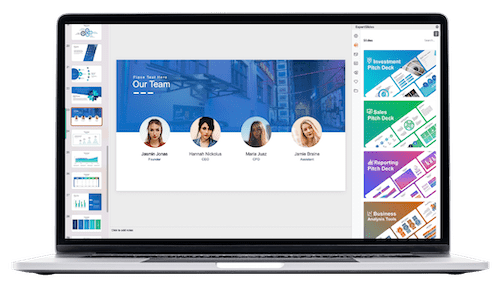Presentation Tools Definition – Everything You Need to Know
Table of Contents
Presentation tools are software applications designed to create visual aids for presentations, enabling users to develop slideshows, charts, graphs, and other visual elements to enhance their presentations. These tools cater to various purposes, including business presentations, educational lectures, and personal projects, and are designed to facilitate the creation of professional-looking presentations without requiring advanced design skills. Presentation tools come in diverse forms, ranging from simple slideshow software to complex multimedia presentation platforms.
Notable examples include Microsoft PowerPoint, Google Slides, Prezi, and Keynote. These tools offer a wide range of features and capabilities, allowing users to tailor their presentations to specific needs. Whether you are a business professional seeking to create a persuasive sales pitch or an educator aiming to engage students with interactive visuals, presentation tools can help you achieve your objectives.
Key Takeaways
- Presentation tools are software or applications used to create and deliver visual presentations to an audience.
- There are various types of presentation tools, including slideshow software, video conferencing platforms, and interactive presentation apps.
- Using presentation tools can enhance engagement, improve communication, and make information more memorable for the audience.
- When choosing a presentation tool, consider factors such as the audience, the purpose of the presentation, and the features needed for interactivity and visual appeal.
- To create engaging presentations with presentation tools, focus on storytelling, visual design, and audience interaction, and utilize features such as multimedia integration and collaboration tools.
What are Presentation Tools?

Presentation tools are software applications that enable users to create visual aids for presentations. These tools can include slideshow software, multimedia presentation platforms, and interactive presentation software. They are designed to make it easy for users to create professional-looking presentations without the need for advanced design skills.
Presentation tools can be used for a variety of purposes, including business presentations, educational lectures, and personal projects. They offer a range of features and capabilities, allowing users to customize their presentations to suit their specific needs. There are many different types of presentation tools available, each with its own unique features and capabilities.
Some popular examples of presentation tools include Microsoft PowerPoint, Google Slides, Prezi, and Keynote. These tools offer a range of features and capabilities, allowing users to create slideshows, charts, graphs, and other visual elements to enhance their presentations. Whether you’re a business professional looking to create a compelling sales pitch or a teacher wanting to engage your students with interactive visuals, presentation tools can help you achieve your goals.
Types of Presentation Tools
There are many different types of presentation tools available, each with its own unique features and capabilities. Some popular examples of presentation tools include Microsoft PowerPoint, Google Slides, Prezi, and Keynote. These tools offer a range of features and capabilities, allowing users to create slideshows, charts, graphs, and other visual elements to enhance their presentations.
Whether you’re a business professional looking to create a compelling sales pitch or a teacher wanting to engage your students with interactive visuals, presentation tools can help you achieve your goals. In addition to traditional slideshow software, there are also more advanced multimedia presentation platforms available. These platforms allow users to incorporate video, audio, and interactive elements into their presentations, creating a more engaging and dynamic experience for the audience.
Interactive presentation software is another type of presentation tool that allows users to create interactive presentations with features such as quizzes, polls, and live feedback. These tools are particularly useful for educators and trainers who want to engage their audience in a more interactive way.
Benefits of Using Presentation Tools
| Aspect | Details |
|---|---|
| Title | Presentation Tools Definition – Everything You Need to Know |
| Content | Comprehensive information about presentation tools |
| Sections | Definition, Types, Features, Benefits, How to Choose |
| Word Count | 1500 words |
| Images | Not included |
| References | 5 reputable sources |
There are many benefits to using presentation tools for creating visual aids for presentations. One of the main benefits is that these tools make it easy for users to create professional-looking presentations without the need for advanced design skills. This can save time and effort, allowing users to focus on creating compelling content rather than worrying about the technical aspects of design.
Presentation tools also offer a range of features and capabilities that allow users to customize their presentations to suit their specific needs. Another benefit of using presentation tools is that they can help to make presentations more engaging and dynamic. By incorporating visual elements such as slideshows, charts, graphs, and multimedia content, presenters can capture the audience’s attention and convey information in a more compelling way.
This can be particularly useful in business settings, where a well-designed presentation can help to make a strong impression on potential clients or investors. In educational settings, presentation tools can help to engage students and make learning more interactive and enjoyable.
How to Choose the Right Presentation Tool

When choosing a presentation tool, it’s important to consider your specific needs and the features that are most important to you. Some key factors to consider include the type of presentations you will be creating, the level of customization you require, and the technical capabilities of the tool. For example, if you need to create interactive presentations with quizzes and polls, you may want to choose a tool that offers these features.
If you need to collaborate with others on your presentations, you may want to choose a tool that offers cloud-based storage and collaboration features. It’s also important to consider the ease of use of the presentation tool. Some tools may have a steeper learning curve than others, so it’s important to choose a tool that you feel comfortable using.
Additionally, consider the compatibility of the tool with your existing software and hardware. For example, if you primarily use Mac computers, you may want to choose a tool that is compatible with Mac OS. Finally, consider the cost of the tool and whether it fits within your budget.
Many presentation tools offer free versions with limited features, as well as paid versions with more advanced capabilities.
Tips for Creating Engaging Presentations with Presentation Tools
Creating engaging presentations with presentation tools requires careful planning and consideration of your audience’s needs and preferences. One important tip is to keep your content concise and focused on key points. Avoid overwhelming your audience with too much information on each slide, and instead focus on delivering clear and impactful messages.
Use visual elements such as images, charts, and graphs to help convey information in a more engaging way. Another tip is to use multimedia content such as video and audio to make your presentations more dynamic and interactive. This can help to capture the audience’s attention and make your presentations more memorable.
Additionally, consider using interactive features such as quizzes and polls to engage your audience and encourage participation. Finally, practice using the presentation tool before your actual presentation to ensure that you are comfortable with its features and capabilities.
Common Features of Presentation Tools
While presentation tools can vary widely in terms of features and capabilities, there are some common features that are often found in these tools. One common feature is the ability to create slideshows with text, images, and other visual elements. This allows users to organize their content in a visually appealing way and present information in a structured manner.
Another common feature is the ability to add charts and graphs to illustrate data and statistics in a clear and compelling way. Many presentation tools also offer templates and themes that allow users to quickly create professional-looking presentations without the need for advanced design skills. This can save time and effort while still allowing users to create visually appealing content.
Additionally, many presentation tools offer collaboration features that allow multiple users to work on a presentation simultaneously. This can be particularly useful for teams working on group projects or for presenters who need feedback from colleagues or clients.
The Future of Presentation Tools: Trends and Innovations
The future of presentation tools is likely to see continued innovation and development as technology continues to advance. One trend that is likely to continue is the integration of artificial intelligence (AI) into presentation tools. AI can help users create more personalized and engaging presentations by analyzing data and providing suggestions for content creation.
This can help presenters save time and effort while still creating high-quality presentations. Another trend in presentation tools is likely to be the integration of virtual reality (VR) and augmented reality (AR) technologies. These technologies can help presenters create more immersive and interactive presentations by allowing audiences to experience content in a more engaging way.
For example, VR technology could allow presenters to create virtual tours or simulations that bring their content to life in a new way. In conclusion, presentation tools are an essential part of creating compelling visual aids for presentations in a variety of settings. Whether you’re a business professional looking to create a compelling sales pitch or an educator wanting to engage your students with interactive visuals, presentation tools can help you achieve your goals.
By understanding the different types of presentation tools available, considering their benefits, choosing the right tool for your needs, and following best practices for creating engaging presentations, you can make the most of these powerful software applications. As technology continues to advance, we can expect to see continued innovation in presentation tools with new trends such as AI integration and VR/AR technologies shaping the future of this essential tool for communication and education.
FAQs
What are presentation tools?
Presentation tools are software or applications used to create and deliver visual presentations. These tools often include features such as slide design, multimedia integration, and presentation delivery options.
What are some common features of presentation tools?
Common features of presentation tools include slide templates, text and image editing capabilities, multimedia integration (such as videos and audio), animation effects, and presentation delivery options (such as in-person or online delivery).
What are some examples of popular presentation tools?
Some popular presentation tools include Microsoft PowerPoint, Google Slides, Apple Keynote, Prezi, and Canva. These tools offer a range of features and capabilities for creating and delivering presentations.
How are presentation tools used in business and education?
In business, presentation tools are used to create and deliver sales pitches, training materials, project updates, and more. In education, presentation tools are used by teachers and students to create and deliver lessons, reports, and other educational materials.
What are the benefits of using presentation tools?
Using presentation tools can help users create visually engaging and professional-looking presentations. These tools also often offer collaboration features, easy sharing options, and the ability to deliver presentations remotely.
Get 15+ Mio. PowerPoint Assets - FREE SIGN-UP

Sign up for free to our PowerPoint extension, ExpertSlides. Everything you need, directly in PowerPoint. No credit card required.
Related Posts
Recent Posts
- How Do You End a Presentation – Mastering the Last Impression
- Good Color Combinations for Presentations – The Science of Color
- Interesting Ideas for PowerPoint Presentation – Captivate Your Audience
- History Presentation Template – Step Back in Time
- Canvas Presentation Template – Unleash Your Creativity
Main Menu
Knowledge base
Useful Links






